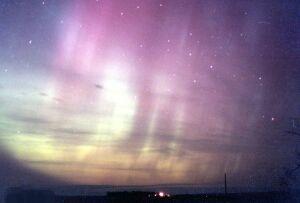The Compass
Effects of atmospheric Disturbances on the Compass
Lightning
Magnetic compasses sometimes can be rendered
inaccurate by a lightning strike on the vessel, or by arc welding in the
close vicinity of a magnetic compass (compass should be temporarily removed
while welding in the vicinity).
Lightning stikes will also affect the reliability
of the GPS receiver and other on-board electronic navigation systems.
Magnetic and Ionospheric Storms
|
Disturbances on the sun may cause disturbances
of the magnetic compass needle and interference with radio communications.
At the time of an intense solar flare or eruption, a flash of ultra-violet
light and a stream of charged particles are emitted from the Sun. The flash
of ultra-violet light takes only 8 minutes to reach the Earth, where it produces
great ionization (electrification) at abnormally low layers of the upper
atmosphere.
In and near auroral zones currents of the
order of a million amperes may circulate in the upper atmosphere. The magnetic
field of the fluctuating currents is appreciable at the Earth's surface and
may deflect a compass needle noticeably from its normal position. The effects
on these so-called magnetic and ionospheric storms, which may persist with
varying intensity for several days, are usually greatest in higher latitudes.
|

|
 |
Deviations of the magnetic compass by several degrees are not uncommon
in and near auroral zones.
When a great aurora is seen in abnormally
low latitudes, it is invariably accompanied by a magnetic and ionospheric
storm. Unlike the "radio fade-out" which occurs only on the sunlit side of
Earth, the interference with radio communications which accompanies an aurora
and magnetic storm may occur by day and at night.
All these effects occur most frequently and
in most intense forms at the time of sunspot maximum; maxima are likely to
occur in 2001-02 with a repetition time of about 11 years.
Increases in solar activity could also affect
the reliability of GPS navigation and other satellite systems (supplying
communication systems).
|
|

